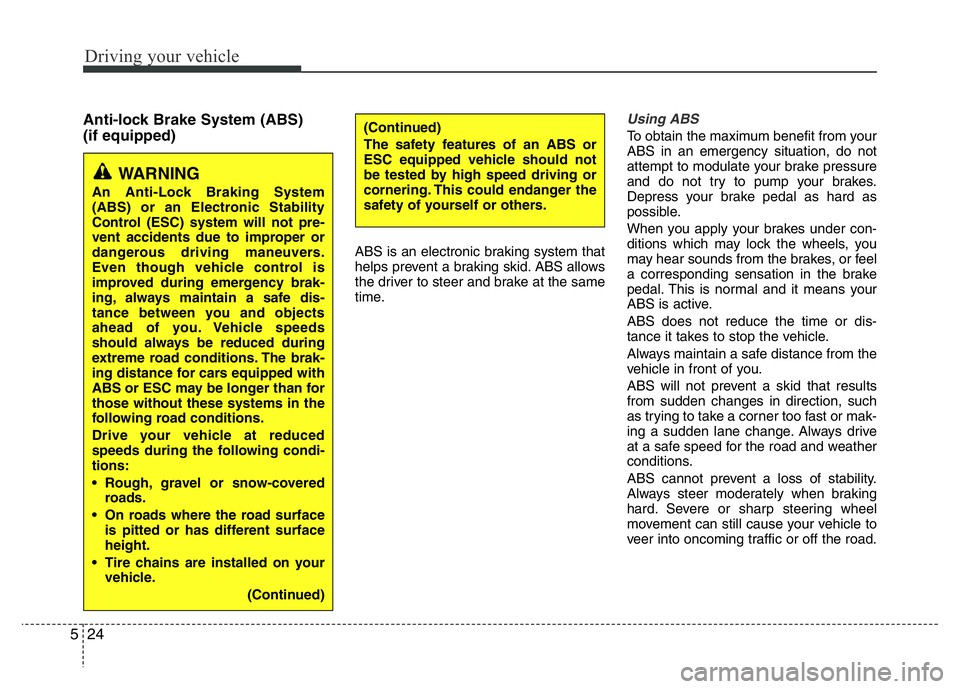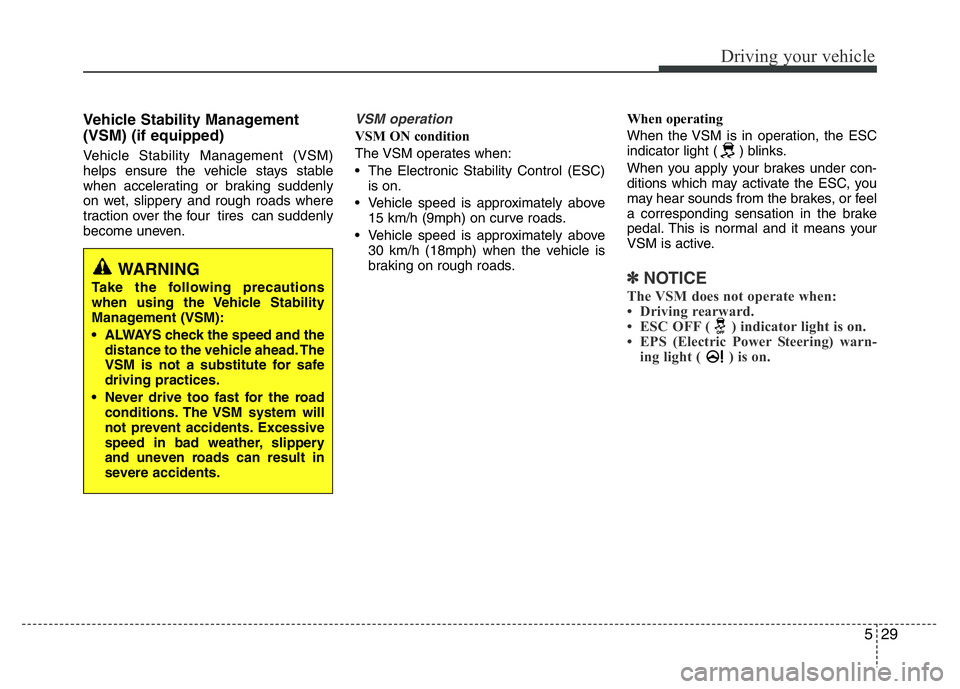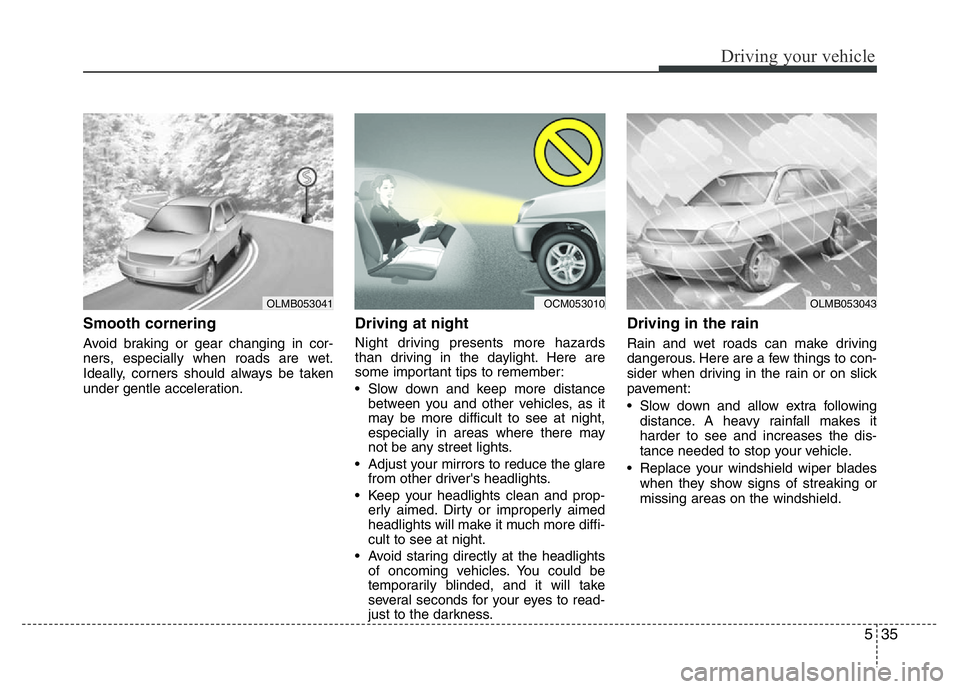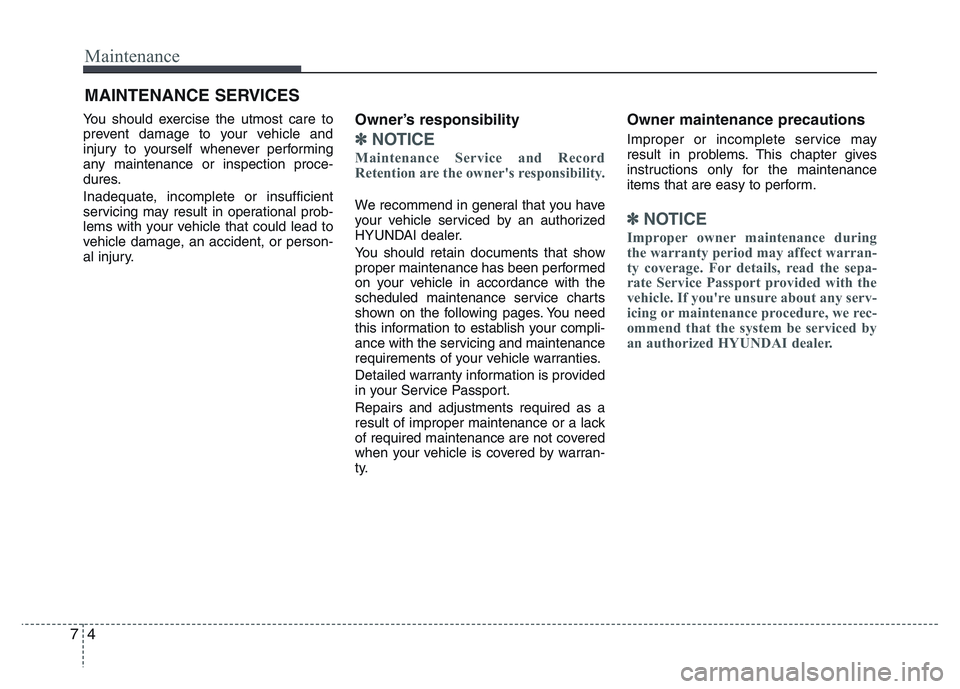2018 HYUNDAI I10 ESP
[x] Cancel search: ESPPage 211 of 343

Driving your vehicle
18 5
Parking
Always come to a complete stop and
continue to depress the brake pedal.
Move the shift lever into the P (Park)
position, apply the parking brake, and
place the ignition switch in the
LOCK/OFF position. Take the Key with
you when exiting the vehicle.
Good driving practices
• Never move the shift lever from P
(Park) or N (Neutral) to any other posi-
tion with the accelerator pedal
depressed.
• Never move the shift lever into P (Park)
when the vehicle is in motion.
• Be sure the vehicle is completely
stopped before you attempt to shift into
R (Reverse) or D (Drive).
• Do not move the shift lever to N
(Neutral) when driving. Doing so may
result in an accident because of a loss
of engine braking and the transaxle
could be damaged.
• Do not drive with your foot resting on
the brake pedal. Even light, but consis-
tent pedal pressure can result in the
brakes overheating, brake wear and
possibly even brake failure.
• When driving in sports mode, slow
down before shifting to a lower gear.
Otherwise, the lower gear may not be
engaged if the engine rpms are out-
side of the allowable range.
• Always apply the parking brake when
leaving the vehicle. Do not depend on
placing the transmission in P (Park) to
keep the vehicle from moving.• Exercise extreme caution when driving
on a slippery surface. Be especially
careful when braking, accelerating or
shifting gears. On a slippery surface,
an abrupt change in vehicle speed can
cause the drive wheels to lose traction
and may cause loss of vehicle control
resulting in an accident
• Optimum vehicle performance and
economy is obtained by smoothly
depressing and releasing the accelera-
tor.
WARNING
When you stay in the vehicle with
the engine running, be careful not
to depress the accelerator pedal for
a long period of time. The engine or
exhaust system may overheat and
start a fire.
The exhaust gas and the exhaust
system are very hot. Keep away
from the exhaust system compo-
nents.
Do not stop or park over flammable
materials, such as dry grass, paper
or leaves. They may ignite and
cause a fire.
Page 217 of 343

Driving your vehicle
24 5
Anti-lock Brake System (ABS)
(if equipped)
ABS is an electronic braking system that
helps prevent a braking skid. ABS allows
the driver to steer and brake at the same
time.
Using ABS
To obtain the maximum benefit from your
ABS in an emergency situation, do not
attempt to modulate your brake pressure
and do not try to pump your brakes.
Depress your brake pedal as hard as
possible.
When you apply your brakes under con-
ditions which may lock the wheels, you
may hear sounds from the brakes, or feel
a corresponding sensation in the brake
pedal. This is normal and it means your
ABS is active.
ABS does not reduce the time or dis-
tance it takes to stop the vehicle.
Always maintain a safe distance from the
vehicle in front of you.
ABS will not prevent a skid that results
from sudden changes in direction, such
as trying to take a corner too fast or mak-
ing a sudden lane change. Always drive
at a safe speed for the road and weather
conditions.
ABS cannot prevent a loss of stability.
Always steer moderately when braking
hard. Severe or sharp steering wheel
movement can still cause your vehicle to
veer into oncoming traffic or off the road.(Continued)
The safety features of an ABS or
ESC equipped vehicle should not
be tested by high speed driving or
cornering. This could endanger the
safety of yourself or others.
WARNING
An Anti-Lock Braking System
(ABS) or an Electronic Stability
Control (ESC) system will not pre-
vent accidents due to improper or
dangerous driving maneuvers.
Even though vehicle control is
improved during emergency brak-
ing, always maintain a safe dis-
tance between you and objects
ahead of you. Vehicle speeds
should always be reduced during
extreme road conditions. The brak-
ing distance for cars equipped with
ABS or ESC may be longer than for
those without these systems in the
following road conditions.
Drive your vehicle at reduced
speeds during the following condi-
tions:
• Rough, gravel or snow-covered
roads.
• On roads where the road surface
is pitted or has different surface
height.
• Tire chains are installed on your
vehicle.
(Continued)
Page 220 of 343

527
Driving your vehicle
When operating
When the ESC is in operation,
the ESC indicator light blinks:
• When you apply your brakes
under conditions which may
lock the wheels, you may
hear sounds from the brakes,
or feel a corresponding sen-
sation in the brake pedal. This
is normal and it means your
ESC is active.
• When the ESC activates, the
engine may not respond to
the accelerator as it does
under routine conditions.
• When moving out of the mud
or driving on a slippery road,
the engine rpm (revolutions
per minute) may not increase
even if you press the acceler-
ator pedal deeply. This is to
maintain the stability and
traction of the vehicle and
does not indicate a problem.ESC OFF condition
To cancel ESC operation,
press the ESC OFF button
(ESC OFF indicator light illumi-
nates).
If the ignition switch is placed
to the LOCK/OFF position
when ESC is off, ESC remains
off. Upon restarting the engine,
the ESC will automatically turn
on again.
Indicator lights
When the ignition switch is placed to the
ON position, the ESC indicator light illu-
minates, then goes off if the ESC system
is operating normally.
The ESC indicator light blinks whenever
the ESC is operating.
If ESC indicator light stays on, your vehi-
cle may have a malfunction with the ESC
system. When this warning light illumi-
nates we recommend that the vehicle be
checked by an authorized HYUNDAI
dealer as soon as possible.
The ESC OFF indicator light comes on
when the ESC is turned off with the but-
ton.
■ESC indicator light (blinks)
■ ESC OFF indicator light (comes on)
Page 222 of 343

529
Driving your vehicle
Vehicle Stability Management
(VSM) (if equipped)
Vehicle Stability Management (VSM)
helps ensure the vehicle stays stable
when accelerating or braking suddenly
on wet, slippery and rough roads where
traction over the four tires can suddenly
become uneven.
VSM operation
VSM ON condition
The VSM operates when:
• The Electronic Stability Control (ESC)
is on.
• Vehicle speed is approximately above
15 km/h (9mph) on curve roads.
• Vehicle speed is approximately above
30 km/h (18mph) when the vehicle is
braking on rough roads.When operating
When the VSM is in operation, the ESC
indicator light ( ) blinks.
When you apply your brakes under con-
ditions which may activate the ESC, you
may hear sounds from the brakes, or feel
a corresponding sensation in the brake
pedal. This is normal and it means your
VSM is active.
✽NOTICE
The VSM does not operate when:
• Driving rearward.
• ESC OFF ( ) indicator light is on.
• EPS (Electric Power Steering) warn-
ing light ( ) is on.
WARNING
Take the following precautions
when using the Vehicle Stability
Management (VSM):
• ALWAYS check the speed and the
distance to the vehicle ahead. The
VSM is not a substitute for safe
driving practices.
• Never drive too fast for the road
conditions. The VSM system will
not prevent accidents. Excessive
speed in bad weather, slippery
and uneven roads can result in
severe accidents.
Page 225 of 343

Driving your vehicle
32 5
REAR PARKING ASSIST SYSTEM (IF EQUIPPED)
The Rear Parking Assist System aids the
driver during backward movement of the
vehicle by chiming if any object is sensed
within the distance of about 120 cm
(47 inches) behind the vehicle. This is a
supplemental system that senses objects
within the range and location of the sen-
sors, it can not detect objects in other
areas where sensors are not installed.
✽NOTICE
The system may not recognize objects
less than 40 cm (15 inches) from the sen-
sor, or it may sense an incorrect dis-
tance.
Operation of the rear parking assist
system
Operation condition
• Sensing distance when backing up is
approximately 120 cm (47 inches)
when you are driving less than 10 km/h
(6 mph).
• When more than two objects are
sensed at the same time, the closest
one will be recognized first.
Types of warning sounds
• When an object is 120 to 81 cm (47 to
32 inches) from the rear bumper:
Buzzer beeps intermittently.
• When an object is 80 to 41 cm (31 to 16
inches) from the rear bumper: Buzzer
sounds two beeps intermittently.
• When an object is within 40 cm (15
inches) of the rear bumper: Buzzer
sounds continuously.
If the audible warning does not sound or
if the buzzer sounds intermittently when
shifting into R (Reverse) position, this
may indicate a malfunction with the
Parking Assist System. If this occurs, we
recommend that your vehicle be checked
by an authorized HYUNDAI dealer as
soon as possible.
OBA043033
OBA044257
WARNING
• ALWAYS look around your vehi-
cle to make sure there are not any
objects or obstacles before mov-
ing the vehicle in any direction to
prevent a collision.
• Always pay close attention when
the vehicle is driven close to
objects, particularly pedestrians,
and especially children.
• Be aware that some objects may
not be visible on the screen or be
detected by the sensors, due to
the objects distance, size or
material, all of which can limit the
effectiveness of the sensor.
CAUTION
Do not push, scratch or strike the
sensor with any hard objects that
could damage the surface of the
sensor. Sensor damage could
occur.
■5 Door
■4 Door
Sensor
Sensor
Page 228 of 343

535
Driving your vehicle
Smooth cornering
Avoid braking or gear changing in cor-
ners, especially when roads are wet.
Ideally, corners should always be taken
under gentle acceleration.
Driving at night
Night driving presents more hazards
than driving in the daylight. Here are
some important tips to remember:
• Slow down and keep more distance
between you and other vehicles, as it
may be more difficult to see at night,
especially in areas where there may
not be any street lights.
• Adjust your mirrors to reduce the glare
from other driver's headlights.
• Keep your headlights clean and prop-
erly aimed. Dirty or improperly aimed
headlights will make it much more diffi-
cult to see at night.
• Avoid staring directly at the headlights
of oncoming vehicles. You could be
temporarily blinded, and it will take
several seconds for your eyes to read-
just to the darkness.
Driving in the rain
Rain and wet roads can make driving
dangerous. Here are a few things to con-
sider when driving in the rain or on slick
pavement:
• Slow down and allow extra following
distance. A heavy rainfall makes it
harder to see and increases the dis-
tance needed to stop your vehicle.
• Replace your windshield wiper blades
when they show signs of streaking or
missing areas on the windshield.
OLMB053041OCM053010OLMB053043
Page 253 of 343

Maintenance
7
ENGINE COMPARTMENT . . . . . . . . . . . . . . . . . . 7-3
MAINTENANCE SERVICES . . . . . . . . . . . . . . . . 7-4
• Owner’s responsibility . . . . . . . . . . . . . . . . . . . . . . . . 7-4
• Owner maintenance precautions . . . . . . . . . . . . . . . . 7-4
OWNER MAINTENANCE . . . . . . . . . . . . . . . . . . . 7-6
• Owner maintenance schedule . . . . . . . . . . . . . . . . . . . 7-6
SCHEDULED MAINTENANCE SERVICE. . . . . 7-8
• Normal maintenance schedule . . . . . . . . . . . . . . . . . . . 7-9
• Maintenance under severe usage conditions. . . . . . . 7-13
EXPLANATION OF SCHEDULED
MAINTENANCE ITEMS . . . . . . . . . . . . . . . . . . . 7-19
ENGINE OIL . . . . . . . . . . . . . . . . . . . . . . . . . . . . . 7-19
• Checking the engine oil level . . . . . . . . . . . . . . . . . . 7-19
• Changing the engine oil and filter . . . . . . . . . . . . . . . 7-23
ENGINE COOLANT . . . . . . . . . . . . . . . . . . . . . . . 7-23
• Checking the engine coolant level . . . . . . . . . . . . . . . 7-23
• Changing the engine coolant . . . . . . . . . . . . . . . . . . . 7-25
BRAKE/CLUTCH FLUID . . . . . . . . . . . . . . . . . . 7-26
• Checking the brake/clutch fluid level . . . . . . . . . . . 7-26
AUTOMATIC TRANSAXLE FLUID . . . . . . . . . 7-27
• Checking the automatic transaxle fluid level . . . . . 7-27
• Changing the automatic transaxle fluid . . . . . . . . . . 7-28
WASHER FLUID . . . . . . . . . . . . . . . . . . . . . . . . . . 7-29
• Checking the washer fluid level . . . . . . . . . . . . . . . . 7-29
PARKING BRAKE . . . . . . . . . . . . . . . . . . . . . . . . 7-29
• Checking the parking brake . . . . . . . . . . . . . . . . . . 7-29
AIR CLEANER . . . . . . . . . . . . . . . . . . . . . . . . . . . 7-30
• Filter replacement . . . . . . . . . . . . . . . . . . . . . . . . . . . 7-30
CLIMATE CONTROL AIR FILTER . . . . . . . . . 7-32
• Filter inspection . . . . . . . . . . . . . . . . . . . . . . . . . . . . . . 7-32
• Filter replacement . . . . . . . . . . . . . . . . . . . . . . . . . . . . 7-32
WIPER BLADES . . . . . . . . . . . . . . . . . . . . . . . . . 7-34
• Blade inspection . . . . . . . . . . . . . . . . . . . . . . . . . . . . . . 7-34
• Blade replacement . . . . . . . . . . . . . . . . . . . . . . . . . . . 7-34
BATTERY . . . . . . . . . . . . . . . . . . . . . . . . . . . . . . . . 7-38
• For best battery service . . . . . . . . . . . . . . . . . . . . . . . 7-38
• Battery capacity label . . . . . . . . . . . . . . . . . . . . . . . . 7-39
• Battery recharging . . . . . . . . . . . . . . . . . . . . . . . . . . 7-39
• Reset items . . . . . . . . . . . . . . . . . . . . . . . . . . . . . . . . . . 7-40
TIRES AND WHEELS . . . . . . . . . . . . . . . . . . . . . 7-41
• Tire care . . . . . . . . . . . . . . . . . . . . . . . . . . . . . . . . . . . 7-41
• Recommended cold tire inflation pressures . . . . . . 7-41
• Checking tire inflation pressure. . . . . . . . . . . . . . . . . 7-43
• Tire rotation . . . . . . . . . . . . . . . . . . . . . . . . . . . . . . . . 7-44
• Wheel alignment and tire balance . . . . . . . . . . . . . . 7-45
• Tire replacement . . . . . . . . . . . . . . . . . . . . . . . . . . . . . 7-45
• Wheel replacement . . . . . . . . . . . . . . . . . . . . . . . . . . . 7-46
• Tire traction . . . . . . . . . . . . . . . . . . . . . . . . . . . . . . . . . 7-46
• Tire maintenance . . . . . . . . . . . . . . . . . . . . . . . . . . . . 7-47
Page 256 of 343

Maintenance
4 7
MAINTENANCE SERVICES
You should exercise the utmost care to
prevent damage to your vehicle and
injury to yourself whenever performing
any maintenance or inspection proce-
dures.
Inadequate, incomplete or insufficient
servicing may result in operational prob-
lems with your vehicle that could lead to
vehicle damage, an accident, or person-
al injury.Owner’s responsibility
✽NOTICE
Maintenance Service and Record
Retention are the owner's responsibility.
We recommend in general that you have
your vehicle serviced by an authorized
HYUNDAI dealer.
You should retain documents that show
proper maintenance has been performed
on your vehicle in accordance with the
scheduled maintenance service charts
shown on the following pages. You need
this information to establish your compli-
ance with the servicing and maintenance
requirements of your vehicle warranties.
Detailed warranty information is provided
in your Service Passport.
Repairs and adjustments required as a
result of improper maintenance or a lack
of required maintenance are not covered
when your vehicle is covered by warran-
ty.
Owner maintenance precautions
Improper or incomplete service may
result in problems. This chapter gives
instructions only for the maintenance
items that are easy to perform.
✽NOTICE
Improper owner maintenance during
the warranty period may affect warran-
ty coverage. For details, read the sepa-
rate Service Passport provided with the
vehicle. If you're unsure about any serv-
icing or maintenance procedure, we rec-
ommend that the system be serviced by
an authorized HYUNDAI dealer.